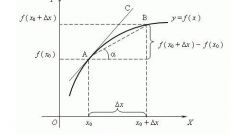Instruction
1
The necessity of differential equations arises when the well-known properties of the function, and she remains an unknown quantity. Often this situation occurs in the study of physical processes. Function properties are described by its derivative, or differential, so the only way the problem is integration. Before proceeding to the solution, we need to determine the form of the differential equation.
2
There are several types of differential equations, the simplest of them is the expression y’ = f(x), where y’ = dy/DX. In addition, this type can be given equality f(x)•y’ = g(x), i.e. y’ = g(x)/f(x). Of course, this is only possible provided that f(x) becomes zero. Example: 3^x•y’ = x2 – 1 → y’ = (x2 - 1)/3^H.
3
Differential equation with separated variables are so named because the derivative of y’ in this case literally split in two components dy and DX, which are on opposite sides of the equal sign. This equation of the form f(u)•dy = g(x)•DX. Example: (Y2 – sin y)•dy = tg x/(x - 1)•DX.
4
Two of the described type of differential equations are called ordinary or abbreviated as ODE. However, the first order equation can be more complex, heterogeneous. They are called LIDE – linear inhomogeneous equation u’ + f(x)•y = g(x).
To LIDE includes, in particular, the Bernoulli equation y’ + f(x)•y = g(x)•y^a. Example: 2•y’ – x2•y = (ln x/X3)•Y2. And the equation in total differentials f(x, y)DX + g(x, y)dy = 0, where ∂FX(x, y)/∂y = ∂do(x, y)/∂X. Example: (X3 – 2•x•y)DX – х2dу = 0, where X3 – 2•x•y – differentiation with respect to x of the function ¼ •x^4 – x2• + C a (x2) – its differentiation with respect to y.
To LIDE includes, in particular, the Bernoulli equation y’ + f(x)•y = g(x)•y^a. Example: 2•y’ – x2•y = (ln x/X3)•Y2. And the equation in total differentials f(x, y)DX + g(x, y)dy = 0, where ∂FX(x, y)/∂y = ∂do(x, y)/∂X. Example: (X3 – 2•x•y)DX – х2dу = 0, where X3 – 2•x•y – differentiation with respect to x of the function ¼ •x^4 – x2• + C a (x2) – its differentiation with respect to y.
5
The simplest form of an ODE of second order is y’ + p•a’ + q•u = 0, where p and q are constant coefficients. LIDE of the second order is a complicated version of the ODE, namely u’ + p•a’ + q•y = f(x). Example: y’ – 5•u’ + 13•y = sin x. once p and q are functions of the argument x, the equation might look like this: y’ – 5•x2•y’ + 13•(x - 1)•y = sin X.
6
Higher orders differential equations are divided into three subspecies: admitting a reduction of order, equations with constant coefficients and with coefficients as functions of the argument x:
• The expression f(x, y^(m)^(m+1),...,^(n)) = 0 do not contain derivatives of lower order m, then, by replacing z= y^(m) it is possible to reduce the order. Then the equation converts to the form f(x, z, z’,..., z^(n - m)) = 0. Example:’’•x – 4•Y2 = y’ - 2 → z’•x – 4•Y2 = z - 2 where z = y’ = dy/DX;
• LOU u^(k) + p_(k-1)•y^(k-1) + ... + p1•y’ + p0•u = 0 and LIDE have^(k) + p_(k-1)•y^(k-1) + ... + p1•y’ + p0•y = f(x) with constant coefficients pi. Examples: y^(3) + 2•’ – 15•y’ + 3•y = 0 and y^(3) + 2•’ – 15•y’ + 3•y = 2•X3 – ln x;
• LOU u^(k) + p(x)_(k-1)•y^(k-1) + ... + p1(x)•y’ + p0(x)•y = 0 and LIDE have^(k) + p(x)_(k-1)•y^(k-1) + ... + p1(x)•y’ + p0(x)•y = f(x) with coefficients-functions pi(x). Examples: y’’ + 2•x2•’ – 15•agsp x•y’ + 9•x•y = 0 and y’’ + 2•x2•’ – 15•arcsin x•y’ + 9•x•y = 2•X3 – ln Kh.
• The expression f(x, y^(m)^(m+1),...,^(n)) = 0 do not contain derivatives of lower order m, then, by replacing z= y^(m) it is possible to reduce the order. Then the equation converts to the form f(x, z, z’,..., z^(n - m)) = 0. Example:’’•x – 4•Y2 = y’ - 2 → z’•x – 4•Y2 = z - 2 where z = y’ = dy/DX;
• LOU u^(k) + p_(k-1)•y^(k-1) + ... + p1•y’ + p0•u = 0 and LIDE have^(k) + p_(k-1)•y^(k-1) + ... + p1•y’ + p0•y = f(x) with constant coefficients pi. Examples: y^(3) + 2•’ – 15•y’ + 3•y = 0 and y^(3) + 2•’ – 15•y’ + 3•y = 2•X3 – ln x;
• LOU u^(k) + p(x)_(k-1)•y^(k-1) + ... + p1(x)•y’ + p0(x)•y = 0 and LIDE have^(k) + p(x)_(k-1)•y^(k-1) + ... + p1(x)•y’ + p0(x)•y = f(x) with coefficients-functions pi(x). Examples: y’’ + 2•x2•’ – 15•agsp x•y’ + 9•x•y = 0 and y’’ + 2•x2•’ – 15•arcsin x•y’ + 9•x•y = 2•X3 – ln Kh.
7
The specific differential equation is not always obvious. Then you should carefully review it to bring to one of the canonical types to apply the appropriate method of solution. This can be done by different methods, the most common ones are replacement and decomposition into components of the derivative y’ = dy/DX.



